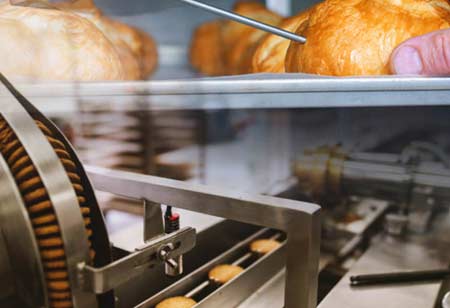Thank you for Subscribing to Food Business Review Weekly Brief
- Home
- Topics
- Alternative Proteins and Plant Based Food
- Beer and Wine
- Canned Beverages
- Coffee And Tea
- Food and Beverage Consulting
- Food and Beverage Financial Service
- Food And Beverages Marketing
- Food Distributors
- Food Ingredients
- Food Sustainability
- Plant Based Food and Beverages
- Seafood Suppliers
- Supplement Manufacturing
- Wine Investment
- News
- Vendor Viewpoint
- CXO Insights
- Conferences
- Newsletter
- CXO Awards
-
Poultry Industry's Process of Food Automation.
Food safety is a top priority in today's chicken sector. Everybody wants to have safe food.

By
Food Business Review | Monday, May 10, 2021
Stay ahead of the industry with exclusive feature stories on the top companies, expert insights and the latest news delivered straight to your inbox. Subscribe today.

Where human labor is replaced by automation, the food manufacturing industry becomes safer.
FREMONT, CA: Food safety is a top priority in today's chicken sector. Everybody wants to have safe food. Despite the poultry meat supply chain extending beyond the processing facility, our industry is ultimately held responsible when the food produced is unsafe. That is why all production procedures must go through food safety. Luckily, there are multiple methods available to ensure chicken food's safe handling. Efficient cleaning, hygiene, cross-contamination prevention, and little human intervention are only a few crucial components.
Automating the process may address these places of focus much more quickly.
Not hands, but eyes: Believe it or not, the most dangerous pollutant in a chicken processing factory is human hands, and each contact can be polluting. Where a process is automatable, machines should perform the labor. Human interference would be confined to supervision through eyes rather than hands in a perfect world.
The product must go through all process phases as efficiently as possible. For example, buffers need costly double handling, but they also reveal the product to temperature increases, which encourages the increase of dangerous germs and reduces shelf life. The aim should be to get products from the live bird hang-on to the cold storage as frequently as possible.
Transport securely: The conveyance must be automated to transport chicken goods safely from point A to B. When the cargo is freed from the shackles, conveyors take over the safe conveyance, assuring the product's honesty is maintained, apart from safely and hygienically transporting products to the next step. Labor's hands do not flip, drop, tumble, or touch the products. The more things are removed during the process, the more protein they lose and the shorter shelf life.
Once products reach the parking area, tray carriers are ideal for transporting them in a food-safe manner. This computer-controlled system suspended the tray carriers from a typical overhead conveyor. They efficiently distribute work over various price/weight labelers, preventing the accumulation of product buffers. It avoids human contact and maximizes floor space.






